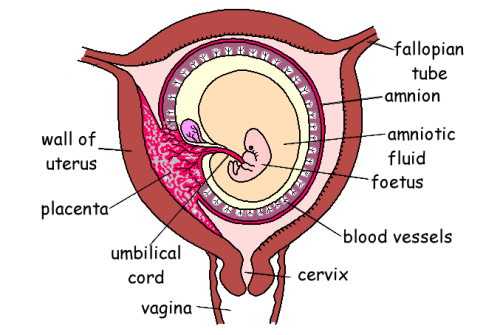Development of the Foetus
The zygote (the fertilised egg) starts to divide by mitosis to form two cells then four cells. By the time it reaches the uterus it is a ball of cells and is called an embryo.
About six days after fertilisation the embryo becomes embedded in lining of the womb. This is implantation. The developing embryo can now take nourishment from the mothers blood.
Some of the embryo's cells will develop into an other structures such as the amniotic sac, umbilical cord and the placenta.

The placenta is attached to the uterine wall. It is a thick disc-like structure attached to the developing foetus by the umbilical cord. The function of the placenta is to exchange materials between the mother's blood and that of the developing child. Food and oxygen are passed from the mother's blood to the foetal blood by diffusion. The carbon dioxide and urea the foetus makes passes by diffusion from the foetal blood to the mother's.
There are other substances which can be passed from the mother's blood to that of the foetus, not all are beneficial. Drugs, alcohol, chemicals in cigarette smoke and viruses can be passed from mother to child via the placenta. Antibodies are also passed on, giving the child an early protection against disease.
The amniotic fluid contained in the amnion cushions the foetus and protects it from shocks.
